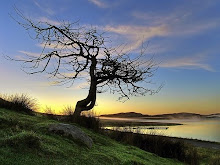Getting to the island is an adventure. From the mainland you first arrive to an A-Frame base camp, a tiny structure surrounded by a small lawn of mowed, fading weeds. From your vantage point high above the shore you can see many large islands, where tall pines and weathered fishing boats abound. It's clear this is not a picturesque tourist town. Piers are old and sagging. Fishing boats are well worn and practical. Even the few summer inhabitants take pride in having a Maine lobster boat (specially made of course) as their water transport. It's hard to believe you're looking at the ocean. All you can see in every direction are pieces of land - islands beyond islands - looking more like just another piece of the land you're standing on.
Having taken your fill of the view, you now head for the steps down to the seashore far below. Many, many, many steps - down and down and down - you're glad you're going down them, and you wonder how much energy it will take to get back up on your return. If it's high tide you hardly need to walk to get to the boat - a simple open aluminum boat with an outboard motor, life-jackets, and a removable ship-to-shore radio. If it's low tide, you've got quite a hike across muddy, sandy beach. You've got on wading boots too, because there's no dock for the boat, so it's anchored out in the water. You resist the temptation to look for shells and stones - although it's pretty hard. Then - wading in the water, you enjoy the feeling of the boots sinking into mud. And you see the sparkle of gasoline rainbow colors on the surface of the water.
In the boat you put on a life jacket and take a seat - in the front or the middle - since you don't need to steer. And you're off - going pretty fast - in the bright sunshine. The wind whipping your hair. The noise of the motor drowning out speech or the sounds of nature. You're glad you've got on your windbreaker and a sunhat that's safely tied. You let your hand dangle in the water for a while and you watch the seagulls, noticing from sea level how high up the piers and the houses on the shore look. Closer up, the houses begin to look small and sad and old.
You're weaving in and out and past islands; you've lost all bearings now. Where did you start from? Where are you going? It takes maybe half an hour - going at a pretty fast clip - before you begin to leave the inhabited islands behind. The islands around now look more beautiful, perhaps a bit lonely, but no longer dejected because of sad old piers and rundown houses.
You have to approach the island at high tide, and in one particular spot, where the boat can sit next to some smooth slate-colored bedrock that drops off very steeply in the low tide. Even at high tide, it's a slippery trick getting up the rocks, hanging onto seaweed, taking a hand from someone in the boat and someone else already on shore.
You realize how dependent you are - on the boat, on the radio, on the life jackets, on the engine, on the wading boots and helping hands, on the food and water others have brought here. The water is very cold and there is no way you could leave by swimming. Only at low tide, and then only with wading boots, going very slowly over the mudflats, could you get to the larger island nearby - an uninhabited place. It is comforting that salmon pools nearby are visited twice a day, when the salmon are fed. For you are here - unable to see land, unable even to see open water - surrounded by lonely seas and quiet islands, stretching all around as far as the eye can see - even with powerful binoculars.
Nature is a wonderful gift. But this patch of nature also brings appreciation for fellow travelers who've taken you in, will provide you with shelter and food and transport and good company.
Wednesday, July 15, 2009
Subscribe to:
Post Comments (Atom)



No comments:
Post a Comment